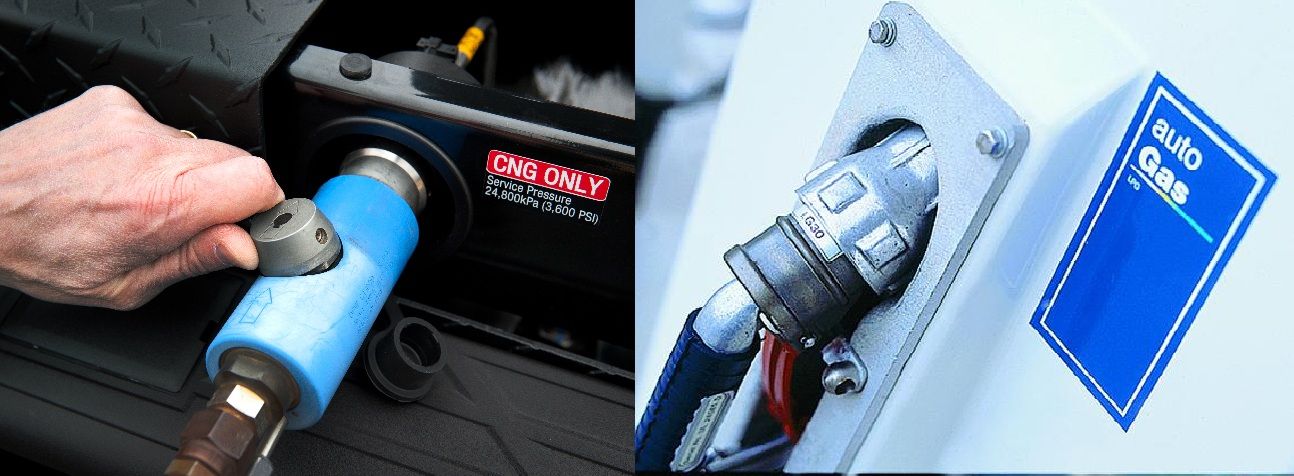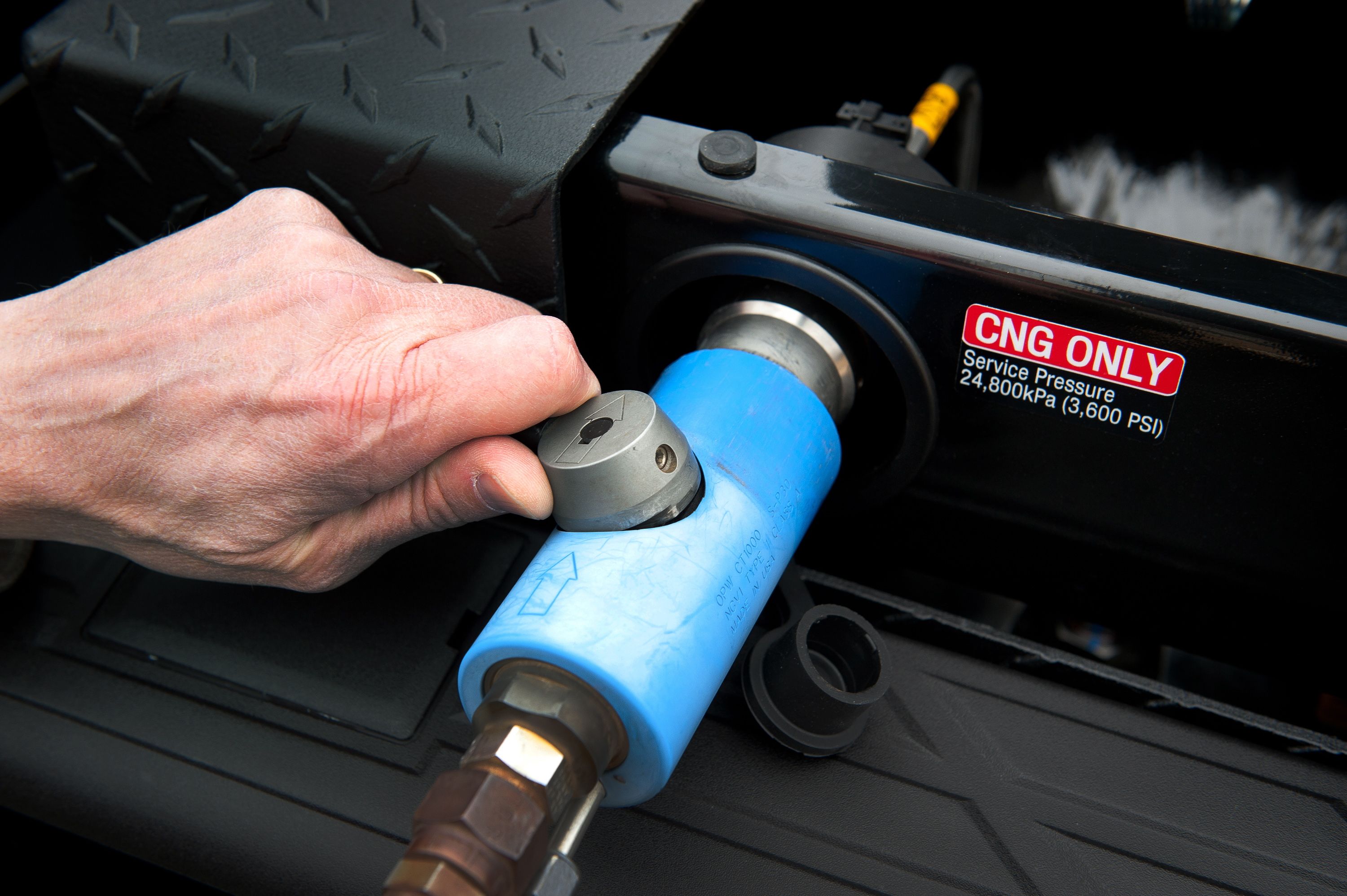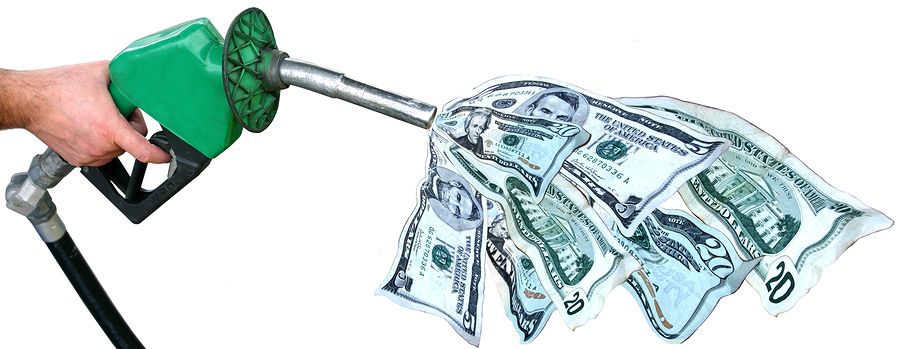So we have watched as electric cars have begun infiltrating the market with maximum ranges of 70 to 150 miles per charge and a roughly 6- to 12-hour charging time. To be honest, that is just not a feasible solution for most drivers. We all know hybrids, as they have been around for what seems like forever now, but they are still reliant on gasoline and some actually get worse gas mileage than some gasoline-only cars.
This all leaves us scratching our heads looking for a solution to the gas crisis we are experiencing. Some people insist that hydrogen is the only real answer, but that experiment is far away from ever becoming a reality. There are two gasses that we have been using for ages to heat our homes and grill our food that a lot of people seem to forget, these are compressed natural gas and liquefied petroleum gas (propane).
Natural gas vehicles have been on the rise lately, with many fleet companies switching over to it, and forklifts have been propane-powered for ages. Recently, we even saw a performance car, the Maxximus LNG 2000 break a number of speed records, using natural gas as its fuel. This leads to the ultimate question of can CNG and LPG make their way into the performance and luxury car world to alleviate the gasoline crisis, especially in regards to fuel-hungry performance and luxury cars, as we find a real alternative?
Click past the jump to find out!
What are CNG and LPG?
CNG and LPG, are both fossil fuels, so don’t think that they are limitless. They will eventually run out, just like oil is starting to. Their benefits are the fact that it is widely available in the U.S., without reliance on other countries, they produce 60 to 90 percent less pollutants, 30 to 40 percent less greenhouse gasses, and are as little as half the price of gasoline.
Both products come from the Earth, much like oil, but are the byproduct of decomposing tissue, plants, and other organisms. Both are combustible gasses, just like gasoline, but they are far less volatile than gasoline, making them safer to transport and use.
There are several distinct differences between LPG and CNG, but they are very similar. The largest difference is that CNG is 100 percent natural, whereas LPG can be obtained from natural gas or petroleum, but both require in-depth synthesizing to convert them into LPG. Another difference is the fact that CNG is natural gas compressed, just as its name alludes to, to roughly 1 percent of its volume at atmospheric pressures. LPG, on the other hand, is stored as a liquid at a far higher pressure than CNG, then converts to a gas when it is depressurized. LPG is also far more expensive to produce than CNG, as it requires elaborate cryogenics to produce.
Pricing and Availability
We’ll start off with the pricing of CNG and its availability in the U.S. The pricing and availability ranges widely throughout the U.S., as an area like San Francisco has over 25 active filling stations ranging from $1.99 per gallon to $2.49 per gallon. Heading to the other side of the country, a place like Tampa, FL has just three stations ranging from $2.05 per gallon to as much as $3.00 per gallon. There are also areas in the country where some sites claim that prices are as low as $0.88 per gallon.
When we move on to LPG, we first notice that the supply is far more even throughout the country, as this is the same gas that we use in gas-powered grills. San Francisco has about 28 filling stations ranging from $3.00 per gallon to a whopping $5.00 per gallon. Moving over to the other side of the country, Tampa has 11 stations within 25 miles, with prices ranging from $2.33 per gallon to $4.20 per gallon.
So as you can see, since the demand is higher for propane, there are more suppliers, but ultimately a higher price. CNG has a limited selection in some areas, but a price that makes it worth the extra drive.
One thing that concerns people is the possibility of running out of fuel. Don’t fret, as most of the CNG and LPG kits you find are bi-fuel, meaning they switch back over to gasoline with a flick of a switch.
Initial Cost
The initial cost of CNG or LPG kits are often a deterrent, considering the fact that GM slapped a whopping $11,000 premium on bi-fuel Silverados->ke1787 and Sierras. Currently, the only car equipped with a CNG/LPG system is the Honda Civic GX CNG and its base price is about $11K higher than the base DX, but it also features more options than the DX model. In all honesty, these kits are relatively inexpensive, if you go aftermarket.
There are two main categories of CNG and Propane kits, aspirated and sequential injection. The aspirated versions are always the cheapest and easiest to install, as they simply hook into the vehicle’s intake and shoot the gas into the intake along with the outside air. The tradeoff for the low price is also inefficiency and power loss. There is no real estimate on the losses, but they are noticeable. These kits sell for as little as $400 on some sites. Sequential kits, on the other hand, typically require professional installation and start out around $2,000 without the tanks. The tradeoff is that there is little to no power and efficiency loss.
This means that if you are running a high-performance vehicle that you would like to make a little “greener,” the more expensive injection system is the only way to go without losing power.
There are two sub categories that often get overlooked, and these are EPA- and non-EPA-certified. This does not mean that non-EPA-certified units are illegal, except in California, but rather that they do not qualify for any tax relief. For example, Utah now offers a 50% tax credit to offset the cost of an EPA-certified CNG system, but without that EPA certification, you get no tax break. In all honesty, the cost difference between a non-EPA-certified unit and an EPA-certified unit more than makes up for the loss of the tax credit.
Pros and Cons
CNG Pros:
-CNG produces 90 percent fewer exhaust emissions than gasoline or diesel
-At 2012 pricing, CNG is as little as one-third of the price of gasoline and diesel
-CNG is abundant and readily available in the U.S.
-CNG is proven to allow an engine to run longer, due to lowered combustion temperatures
-CNG rapidly disperses into the air, so spills cause no issues
-CNG is completely non-toxic
-CNG has a narrow flammability range optimal for use as a fuel, but limiting its combustibility
-Tax credits for approved systems
CNG Cons:
-Requires a lot of extra weight for storage in a vehicle
-Can sharply decrease performance and fuel economy of a vehicle
-Is still an exhaustible resource, so it is only a temporary solution
-May require added drilling in U.S. to satisfy demand if it grows in popularity
-Filling stations are scarce in some areas leading to prices higher than gasoline
-Require expensive kits for vehicles for optimal performance
-Difficult to transport over long distances
-Repair technicians tend to shy away from repairing these systems
-Will void nearly every new car warranty
-Many fly-by-night kits are popping up all over the internet and quality is getting low
-Relatively young as an automotive fuel
-Odorless, so knowing there is a leak can be difficult
LPG Pros:
-Dates back to the 1940s as an automotive fuel source
-Readily available in the U.S. without dependence on overseas sources
-Completely non-toxic and non-corrosive
-High octane rating
-Low CO emissions at high engine load
-In some areas, pricing is slightly lower than gasoline
-Filling stations are plentiful throughout the U.S.
-Works very well in diesel engines
-Easy to store
-When used as a sole fuel source, noxious exhaust emissions are reduced
-Government tax credits for conversion
LPG Cons:
-Prices are significantly higher than gasoline in some areas
-Lower energy output results in reduced fuel economy and performance
-When used as a supplemental fuel, hydrocarbon emissions actually increase under light to moderate engine load
-Can cause valve damage in non-modified vehicles
-Injector kits and installation can become very expensive
-Heavier than air, so it tends to form highly flammable gas pools
-Storage tanks add a lot of weight to a car, even more than CNG
-Still a fossil fuel that will eventually disappear
-Auto repair techs tend to avoid repairing them
-Wider flammability band than CNG, making more expensive storage tanks necessary
Who Uses CNG and LPG?
As of 2010, there were 12.7 million CNG and LPG vehicles in the world. The U.S. is near the bottom of the pack when it comes to using CNG or LPG to power vehicles, as we tend to be a little more leery of alternative fuels. The list tops out with Pakistan, which has 2.7 million CNG or LPG cars on the road, as the U.S. only has about 267,000 natural gas vehicles on the road.
The European market at this point appears to be more focused on the clean diesel market than natural gas, as they are about even with the U.S. The only one that really stands out is Italy, who had 730,000 natural gas vehicles in 2010.
In Luxury and Performance Models
As we saw with the Maxximus LNG 2000, a performance car that runs on Eco-friendlier natural gas can also be a real screamer, as it cranks out over 1,600 horsepower and sprints to 60 mph in less than two seconds. The only problem is that Maxximus did not tell us what kind of mpg to expect from this supercar. If the thing eats up and entire 50-pound tank of natural gas to run a quarter mile, it pretty much defeats the purpose.
With electricity able to create so much more driving excitement at a fraction of the cost, seeing an LPG of CNG performance segment would be rather unlikely. Having said that, if the electric market completely collapses on itself due to pricing or safety issues – both of which are still possibilities – car manufacturers could turn to the more proven alternative fuel, natural gas. The most recent explosion of a battery in a GM plant is just one example of a safety issue that could put electric cars on hold for a while.
Luxury cars, on the other hand, seem a perfect fit for CNG or LPG. First and foremost, many company fleets already feature natural-gas powered cars, so the concept of making their company executive cars into natural gas machines isn’t out of the question. Add in the fact that luxury cars are more about posh equipment, rather than raw performance, makes this an even more intriguing option. Also, adding $10,000 onto the sticker on a $55,000 BMW to offset the natural gas equipment is much less of a shock than adding the same amount onto a $15,000 Civic. Lastly, with all of the electric gadgets and gizmos inside of today’s luxury cars, a battery-powered motor is simply not in the cards.
Conclusion
In the end, we have to consider one thing. Natural gas has been around as a fuel source forever and car manufacturers have never really tapped it as a legit source, with the exception of Honda. Why on Earth would they suddenly decide to do it now? The answer is that without a catastrophic happening in the electric car realm or gasoline getting too expensive to afford, there is no reason for auto manufacturers to consider it.
Like we said before, there are still some distinct possibilities, but at this time it seems like there is little chance of manufacturers switching to it. However, with the prices of natural gas conversion kits dropping steadily, you can retro fit literally any car – yes, even a 1,200-horsepower Bugatti Veyron->ke1112 – with a CNG or LPG kit. You have to keep in mind though; this is still an exhaustible resource that will eventually hit the same price level we are at with gasoline. Eventually a non-fossil fuel, like hydrogen or non-coal produced electricity, would have to take its place.




